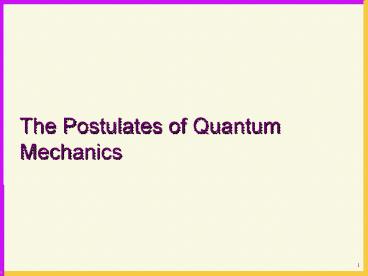The Postulates of Quantum Mechanics PowerPoint PPT Presentation
1 / 8
Title: The Postulates of Quantum Mechanics
1
The Postulates of Quantum Mechanics
2
Postulate I the Board and the Game Tools
The system state can be described by a
wavefunction defined in the domain of all
possible states of the system.
- For a single particle the possible state space is
the set of the spatial coordinates in which the
particle can reside
- For a system composed of numerous particles the
state space includes all the states of all the
particles. The aspiration is to move to a reduced
description of the system (for example moving to
the center of mass coordinates )
In the future an additional coordinate will
be considered. For example the spin coordinate.
3
Postulate II the Rules of the Game
The change of the system state in time can be
described by the evolution operator
- The evolution operator is a linear operator,
which fulfills properties of a group (Unitary
Operator)
- The generator of the evolution group is the
energy operator (The Hamiltonian)
- The eigenfunctions of the Hamiltonian operator
are also the eigenfunctions of the evolution
operator (stationary states)
4
Postulate III the Trial Interface
A measuring action performed on the system can be
described as an action of filtering the
wavefunction into its components.
- Each measurable quantity has a corresponding
Hermitian Operator, whose eigenfunctions
constitute a basis set for filtering. Each
eigenfunction has a corresponding real eigenvalue
which constitutes a possible result of the
measurement
- The state of the system can be written as a
superposition of the basis states
5
Postulate III the Trial Interface
- The result of the measurement is the realization
of the system in only one of its basis states.
The measuring process causes a reduction of the
superposition (wave-like) to a single component
(particle-like)
- The probability for a system in a state ?? to
be realized in a basis state?n? is
- The measurement produces for each particle an
experimental single value, equal to the
eigenvalue ?n of the realized eigenstate ?n?
6
The Normalization Requirement
The following must be fulfilled for the square of
the wavefunction to have a probability density
significance
On the other hand
And therefore
7
Average and Expected Values in Statistics
When a fair dice whose faces are marked by the
digits 1,2,2,4,4,4 is tossed once, the domain of
possible events is
If the dice is tossed N times, the average value
obtained is
After numerous tosses the value ni/N converges to
the probability for event Pi and the expected
value is
8
Average and Expectation Values in Quantum
Mechanics
For each single measurement an eigenvalue of the
measuring operator is obtained
The domain of possible events is ?n
An experimental measurement is composed of a huge
number of single measuring actions, and therefore
the average equals the expectation value. The
experimental result is called the expectation
value of the observation

